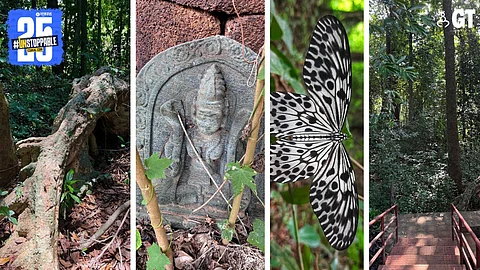

In an eye-opening question-and-answer session that followed a presentation on Goa’s sacred groves by independent researcher and visiting faculty Derek Monteiro—drawn from his PhD research in Management Studies—the conversation quickly moved beyond academic boundaries.
What began as a scholarly talk transformed into a heartfelt discussion on Goa's dying culture and heritage. The evening became a poignant call to protect the under-threat sacred groves in Goa's hinterlands, most of them in Sattari taluka. The dialogue that unfolded was not just about trees and temples; it was about Goa at a risk of losing its natural abundance.
The grouse of the speaker was that the sacred groves, once revered as spaces where deities dwelled, were now quietly thinning. The immediate threats, he said, were both visible and invisible.
Deforestation, encroachment, idol theft, and the fading of faith among the younger generation are slowly bleeding these ancient spaces of their sanctity. What makes this erosion even more tragic is the near-total absence of official documentation and conservation mechanisms.
Deforestation, encroachment, idol theft, and the fading of faith among the younger generation are slowly bleeding these ancient spaces of their sanctity.
As Derek pointed out, while he has been visiting these groves for over six years and plans to re-wild some with the help of friends and local communities, the degradation is palpable. The reason behind it may be unclear, but its effects are right before our eyes: trees disappearing, biodiversity declining, and spiritual artefacts are scattered or missing.
He, along with some of those with knowledge of the groves, is attempting to reintroduce indigenous species into groves like Nagvechi Rai in Sattari taluka. But without broader structural support, these efforts will always remain a drop in the ocean, he rued.
One of the most powerful moments of the question-and-answer session came when a participant, a teacher, noted that while climate change is an ever-present environmental threat, the real danger to the sacred groves might be something far less discussed, and that is diminishing faith.
It is this belief system that sustained these groves for generations, and now, that very belief is flickering or dying. The younger generation, disconnected from their local cultural roots, may not feel the same reverence for these sites. As a result, that emotional and spiritual connection is lost.
The younger generation, disconnected from their local cultural roots, may not feel the same reverence for these sites. As a result, that emotional and spiritual connection is lost.
Another troubling issue is the slow, quiet disappearance of idols from these groves. These are not just heritage crimes; they are spiritual transgressions. Many of these idols are hundreds of years old, but their significance often goes unrecorded.
"Iconography may help find out their era, but carbon dating and other scientific analyses remain off the table because the locals, quite rightly, do not allow them to be disturbed. Still, without an inventory, how many idols have we already lost?" questioned another heritage expert.
It was also pointed out that heritage structures inside the groves are being replaced in the name of “modernisation.” The result? Centuries-old carvings and pillars are left to rot outside while gleaming concrete replaces them.
The discussion revealed a shocking case from 2015 where intricately carved pillars with a tiger holding a boar were left lying in the open near a sacred site. When the community was asked why they weren’t preserved, some locals simply said they had no use for them in the new structure. It’s a painful reminder that ignorance can be as dangerous as apathy.
It was also pointed out that heritage structures inside the groves are being replaced in the name of “modernisation.” The result? Centuries-old carvings and pillars are left to rot outside while gleaming concrete replaces them.
One of them suggested that bringing international recognition, such as UNESCO World Heritage status, could offer some kind of protection. Replying to the suggestion one speaker rightly said, “UNESCO won’t come unless we invite them with a compelling case.”
That compelling case must be built by academics, students, locals, and citizens who care. We must document, photograph, list, and raise awareness before these groves become mere memories.
The role of local knowledge cannot be overstated. One anecdote shared by Derek revealed how even navigating a grove can be a lesson in humility and respect. While documenting flora during a summer trip, he was swarmed by massive bees.
The local guide instructed him to walk backwards, not out of superstition, but because turning quickly or panicking would have created counter air pressure and body vibrations, triggering the bees to attack. This knowledge, unwritten but deeply embedded in oral traditions, is also at risk of extinction.
Even as the government drafts new heritage policies, time is running out. Sacred groves are often surrounded by construction sites with no protective buffer zones.
Even as the government drafts new heritage policies, time is running out. Sacred groves are often surrounded by construction sites with no protective buffer zones. One speaker noted how real estate development is now eating into the groves themselves, not just their fringes. Buffer zones must be demarcated, not in theory, but on the ground, and urgently.
What the session made abundantly clear is that Goa’s sacred groves are facing a combination of challenges. It's not just about deforestation or idol theft. It's about neglect, lack of documentation, community disconnection, and an urgent need for educational interventions.
These groves represent Goa’s spiritual, ecological, and cultural fabric, and preserving them is no longer just a heritage concern, but a moral imperative.
If there’s one call to action from this session, it’s this: Goa must wake up before the silence in its sacred groves becomes permanent.